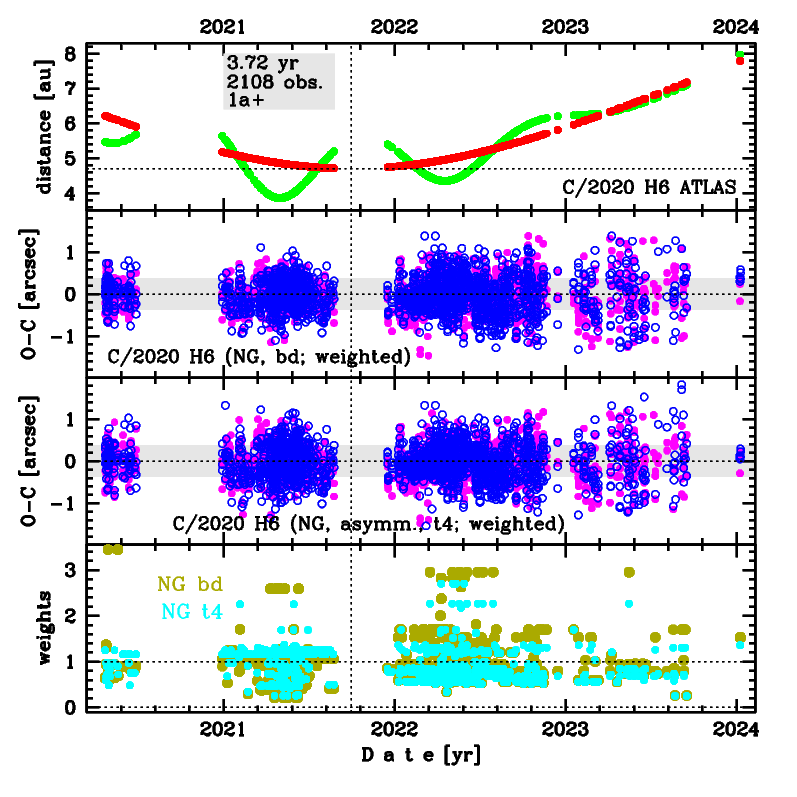C/2020 H6 ATLAS
more info
Comet C/2020 H6 was discovered on 22 April 2020, about 1.3 yr before its perihelion passage. This comet was observed until 8 January 2024 (as in February 2025).
Comet had its closest approach to the Earth on 30 April 2021 (3.86 au); about six months before its perihelion passage.
The preferred NG solution ('bd') given here is based on data span over 3.72 yr in a range of heliocentric distances: 6.22 au – 4.70 au (perihelion) – 7.80 au. Orbits based on pre-perihelion and post-perihelion data independently are also presented.
This Oort spike comet suffers moderate planetary perturbations during its passage through the planetary system that lead to a significantly more tight future orbit (semimajor axis of about 2,000 au).
Comet had its closest approach to the Earth on 30 April 2021 (3.86 au); about six months before its perihelion passage.
The preferred NG solution ('bd') given here is based on data span over 3.72 yr in a range of heliocentric distances: 6.22 au – 4.70 au (perihelion) – 7.80 au. Orbits based on pre-perihelion and post-perihelion data independently are also presented.
This Oort spike comet suffers moderate planetary perturbations during its passage through the planetary system that lead to a significantly more tight future orbit (semimajor axis of about 2,000 au).
| solution description | ||
|---|---|---|
| number of observations | 2108 | |
| data interval | 2020 04 22 – 2024 01 08 | |
| data type | perihelion within the observation arc (FULL) | |
| data arc selection | entire data set (STD) | |
| range of heliocentric distances | 6.22 au – 4.70 au (perihelion) – 7.8 au | |
| type of model of motion | NC - non-gravitational orbits for symmetric CO-g(r)-like function | |
| data weighting | YES | |
| number of residuals | 4141 | |
| RMS [arcseconds] | 0.38 | |
| orbit quality class | 1a+ | |
| orbital elements (heliocentric ecliptic J2000) | ||
|---|---|---|
| Epoch | 2021 09 23 | |
| perihelion date | 2021 10 01.07888425 | ± 0.00031623 |
| perihelion distance [au] | 4.70288250 | ± 0.00000136 |
| eccentricity | 1.00071031 | ± 0.00000195 |
| argument of perihelion [°] | 20.348381 | ± 0.000044 |
| ascending node [°] | 213.706478 | ± 0.000003 |
| inclination [°] | 79.967117 | ± 0.000004 |
| reciprocal semi-major axis [10-6 au-1] | -151.04 | ± 0.42 |

Upper panel: Time distribution of positional observations with corresponding heliocentric (red curve) and geocentric (green curve) distance at which they were taken. The horizontal dotted line shows the perihelion distance for a given comet whereas vertical dotted line — the moment of perihelion passage.
Middle panel(s): O-C diagram for a given solution (sometimes in comparison to another solution available in CODE), where residuals in right ascension are shown using magenta dots and in declination by blue open circles.
Lowest panel: Relative weights for a given data set(s).
Middle panel(s): O-C diagram for a given solution (sometimes in comparison to another solution available in CODE), where residuals in right ascension are shown using magenta dots and in declination by blue open circles.
Lowest panel: Relative weights for a given data set(s).
| non-gravitational parameters | ||
|---|---|---|
| A1 [10-8au/day2] | 0.11762 | ± 0.04506 |
| A2 [10-8au/day2] | -0.75403 | ± 0.08254 |
| A3 [10-8au/day2] | -0.33001 | ± 0.01566 |
| m | -2.00 | |
| n | 3.000 | |
| k | -2.6000 | |
| r0 [au] | 10.000 | |
| α | 0.0100 | |